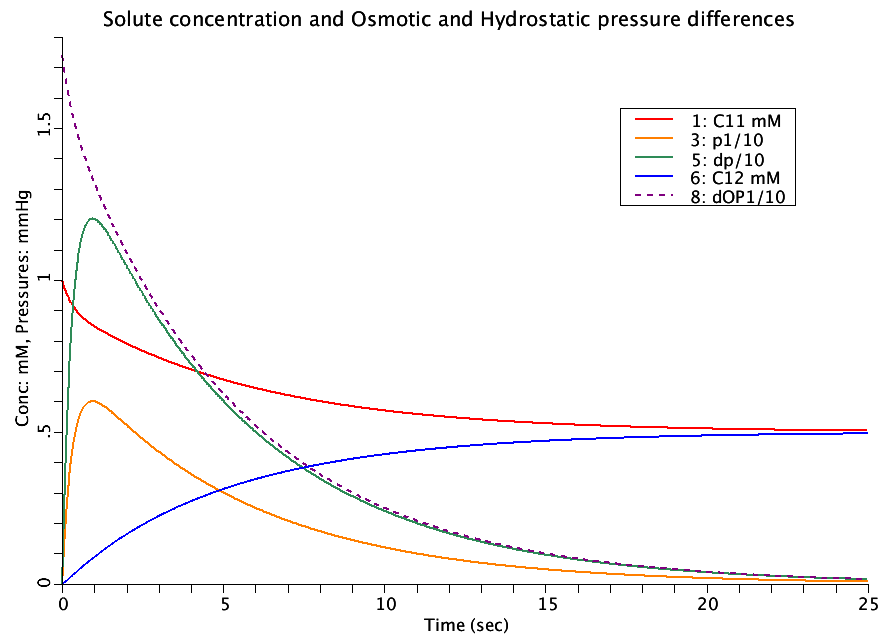Transport across a membrane between 2 stirred tanks, V1 and V2 of solute 1 and solvent water. Water fluxes induce volume changes and pressure changes. Solute 1 can also permeate the membrane independently of the pore, Pmemb11, and so can water PmembW. This uses linearized thermodynamics of irreversible processes from Kedem and Katchalsky 1958.
Description
Model for coupled fluxes of water and one solute through an aqueous channel, with permability Ppore via the pore (aqueous channel). Diffusion with or against water flow affects solute flux. Solute diffusion is retarded by friction with channel wall, by a fraction 1-sigma. Permeability Ppore cm/s = Dw * AreaPore* (1-sigma) / (PoreLength *AreaMemb), where Dw is the free diffusion coeff in water. Sigma (approx) = 1- (1 - rs/rp)^2, where rs is solute radius, and rp is pore radius, assuming spherical solute traversing a cylindrical pore. In this same project file is another program, PoreTransp.P.Sig, which can be used to set P and sig1 in accord with the hydrodynamics of a right cylindrical pore. COMMENTARY: Pure porous transport is not so common in biological membranes. For water and a single solute consider: (1) porous transport of both in a channel where they must interact, (2) water transport independent of the solute through the membrane (passive) by dissolution or via aquaporin channels not available to solute, and (3) solute transport via dissolution in membrane (passive) or via pumps or transporters that might be ATP-assisted (active) or passive. This model code provides for (1) when both Pmembw and Ppore1 = 0." For model (2) Pmembw > 0. For model (3) Pmemb1 > 0. Water pressure is calculated by considering volume to have a column with a small base area so that increased volume requires an increased column height, thus providing hydrostatic pressure to oppose the osmotic pressure.

Equations
The equations for this model may be viewed by running the JSim model applet and clicking on the Source tab at the bottom left of JSim's Run Time graphical user interface. The equations are written in JSim's Mathematical Modeling Language (MML). See the Introduction to MML and the MML Reference Manual. Additional documentation for MML can be found by using the search option at the Physiome home page.
- Download JSim model MML code (text):
- Download translated SBML version of model (if available):
We welcome comments and feedback for this model. Please use the button below to send comments:
Katchalsky A and Curran PF. Nonequilibrium Thermodynamics in Biophysics.
Cambridge, MA; Harvard University Press, 1965.
Kedem O and Katchalsky A. Thermodynamic analysis of the permeability
of biological membranes to non-electrolytes. Biochim Biophys Acta 27: 229-246, 1958.
Stein WD. The Movement of Molecules across Cell Membranes. New York; Academic Press, 1967.
Stein WD. Transport and Diffusion across Cell Membranes. Orlando, Florida; Academic Press Inc., 1986.
Bassingthwaighte JB. A practical extension of hydrodynamic theory of porous transport
for hydrophilic solutes. Microcirculation 13: 111-118, 2006. (for estimating sigma and Ppore
from dimensions of solute and pore.
Please cite https://www.imagwiki.nibib.nih.gov/physiome in any publication for which this software is used and send one reprint to the address given below:
The National Simulation Resource, Director J. B. Bassingthwaighte, Department of Bioengineering, University of Washington, Seattle WA 98195-5061.
Model development and archiving support at https://www.imagwiki.nibib.nih.gov/physiome provided by the following grants: NIH U01HL122199 Analyzing the Cardiac Power Grid, 09/15/2015 - 05/31/2020, NIH/NIBIB BE08407 Software Integration, JSim and SBW 6/1/09-5/31/13; NIH/NHLBI T15 HL88516-01 Modeling for Heart, Lung and Blood: From Cell to Organ, 4/1/07-3/31/11; NSF BES-0506477 Adaptive Multi-Scale Model Simulation, 8/15/05-7/31/08; NIH/NHLBI R01 HL073598 Core 3: 3D Imaging and Computer Modeling of the Respiratory Tract, 9/1/04-8/31/09; as well as prior support from NIH/NCRR P41 RR01243 Simulation Resource in Circulatory Mass Transport and Exchange, 12/1/1980-11/30/01 and NIH/NIBIB R01 EB001973 JSim: A Simulation Analysis Platform, 3/1/02-2/28/07.

